A toothbrush plays a major role in maintaining oral health and hygiene. With various types available in the market, selecting the right toothbrush can impact your dental care routine and overall oral health. Here is more information on toothbrush options through the lens of general dentistry, which will help you make informed decisions for effective cleaning and gum care:
Exploring Manual vs Electric
One common general dentistry decision involves choosing between a manual toothbrush and an electric toothbrush. Manual toothbrushes are simple yet effective when used with proper technique. They are widely available, budget-friendly, and easy to transport, making them a strong choice for everyday use and travel.
Electric toothbrushes, on the other hand, are equipped with features such as oscillating or rotating bristles to maximize cleaning efficiency. These toothbrushes can improve plaque removal and assist individuals with limited dexterity due to their ease of use. Electric models often include timers or sensors that encourage proper brushing time and pressure, which aligns with general dentistry’s recommendation for effective oral care routines.
Selecting the Right Bristles
Bristle type is another primary factor when selecting a toothbrush. Toothbrushes typically come with soft, medium, or hard bristles, which can influence the impact on teeth and gum tissue. To maximize results, bristles should be made of high-quality nylon material and shaped to reach between teeth without straining enamel. Angled bristles or multi-level designs provide an additional advantage in hard-to-reach areas of the mouth for enhanced cleaning.
Soft-bristled toothbrushes are commonly recommended by dental professionals as they clean effectively without causing damage to enamel or gum irritation. Medium and hard bristles may pose a risk of enamel wear or gum recession over time, especially if used with excessive force. Individuals with sensitive gums or existing dental concerns may find more comfort and effectiveness using soft-bristled options.
Understanding Overall Design
The design of a toothbrush handle and head affects how efficiently it cleans and how comfortable it is to use. Handles should offer a secure grip and be easy to maneuver for thorough reach of all areas of the mouth. Toothbrushes with ergonomic designs or non-slip grips provide added control during brushing. For children, smaller handles can help develop proper brushing habits early.
The size and shape of the toothbrush head also matter. A smaller, compact head better accesses difficult areas such as molars and tight gaps between teeth, enabling comprehensive cleaning. Designs featuring rubber additions for massaging gums or tongue cleaners can further elevate hygiene results.
Learn More About General Dentistry
A well-suited toothbrush supports daily oral health care and promotes overall dental hygiene. When deciding on a toothbrush, focus on its ability to meet individual needs and align with professional recommendations from general dentistry. Whether opting for a manual or electric model, soft bristles and an ergonomic design typically yield the best results. Proper brushing habits matter as much as finding the right toothbrush. Pairing a quality toothbrush with good technique contributes to effective plaque removal, gum health, and clean teeth. For tailored advice regarding your unique oral health needs, consult a dental professional.


Leave a Reply